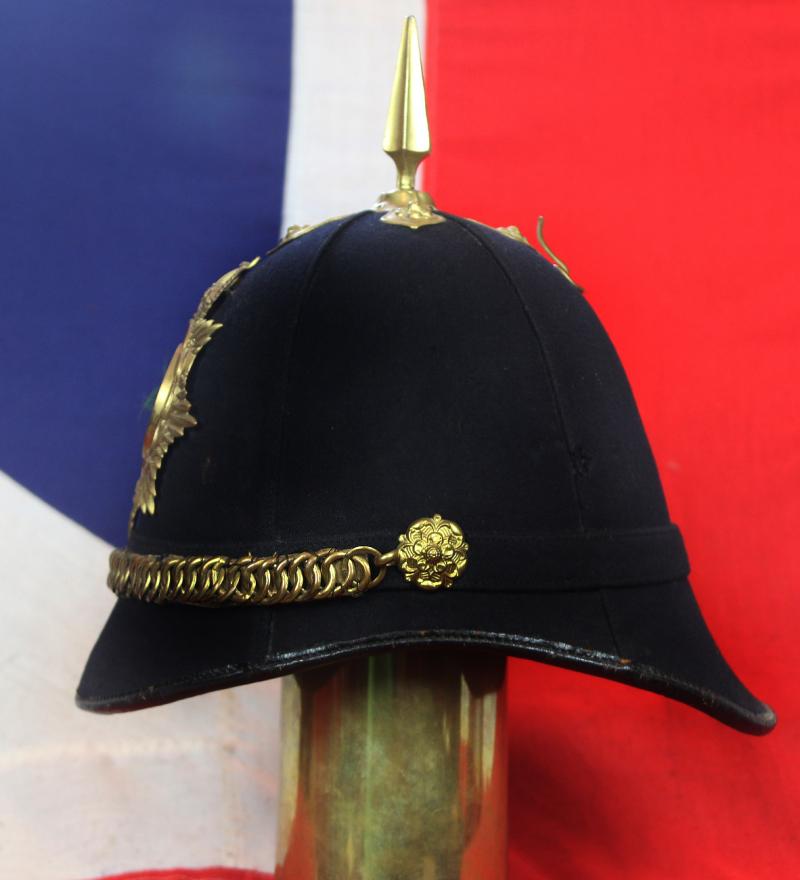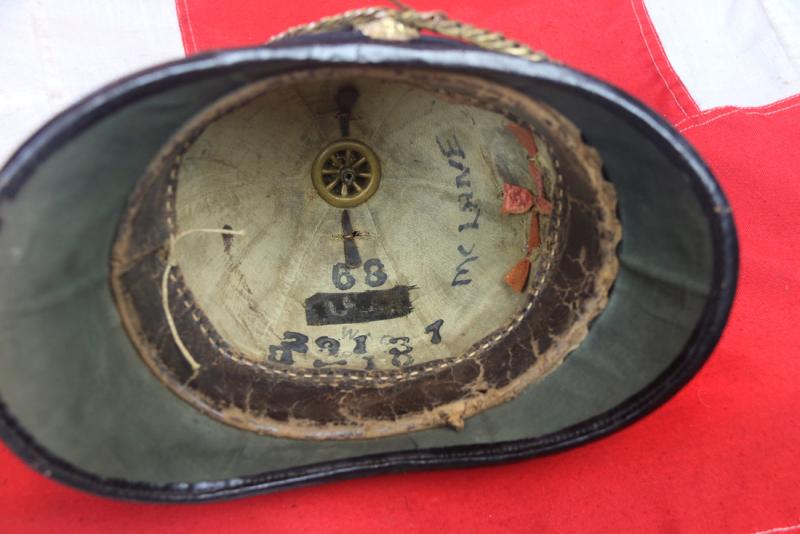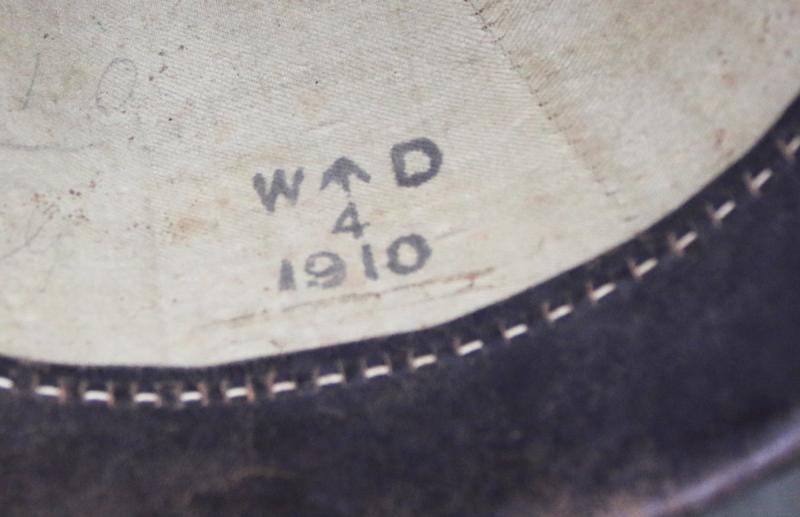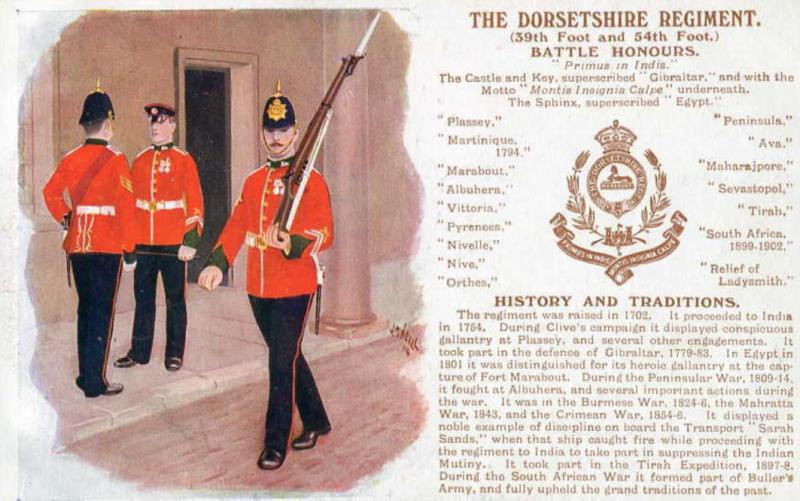A Superb Antique Edwardian Service Helmet of The Dorsetshire Regiment. Blue Cloth with Gold Badge, Fittings, Spike, & Rose Head Curb Chain Mounts and Chin Chain
The Dorsetshire Regiment was established in the Regular Army in 1881 under the Childers Reforms by the amalgamation of the 39th (Dorsetshire) Regiment of Foot and the 54th (West Norfolk) Regiment of Foot. The 1st Battalion was stationed in Malta from 1888, in Egypt from 1889, and in British India from 1893, where it took part in operations in the Tirah Campaign on the North West Frontier in 1897–98.
The 2nd Battalion was stationed in Ireland from 1893 to 1897, then in Malta from 1899. Following the outbreak of the Second Boer War in late 1899, they were sent to South Africa, participating in the Relief of Ladysmith. The battalion stayed in South Africa throughout the war, which ended in June 1902 with the Peace of Vereeniging. Four months later 300 officers and men left Cape Town on the SS German in late September 1902, and arrived at Southampton in late October, when they were posted to Portland.
In 1908, the Volunteers and Militia were reorganised nationally, with the former becoming the Territorial Force and the latter the Special Reserve; the regiment now had one Reserve battalion and one Territorial battalion.
First World War
During the First World War, nine hostilities-only battalions were formed, six battalions serving overseas. The 1st Battalion and 6th (Service) battalion served on the Western Front throughout most of the war. Additional battalions (1/4th Battalion, 2/4th Battalion and 3/4th Battalion) were formed as part of the Territorial Force to meet the demand for troops on the Western Front.
Regular Army
The 1st Battalion was in Belfast when war broke out: it landed at Le Havre in August 1914 forming part of the 15th Brigade in the 5th Division. It transferred to 95th Brigade in the 32nd Division in December 1915 and to the 14th Brigade in the same Division in January 1916.
British Army recruiting poster : "4th Batt. Dorset Regiment. Men Of Dorset ! Your King And Country Need You. Join Your County Battalion".
The 2nd Battalion was in Poona, India, when war broke out and was shipped, as part of the 16th Indian Brigade, to Mesopotamia, where it was trapped in the Siege of Kut and captured by the Turks. (Of the 350 men of the battalion captured, only 70 survived their captivity.) During the siege, returning sick and wounded, and the few replacements who had been sent out, were unable to re-join their battalion, so they, and similar drafts of the 2nd Norfolk Regiment, were amalgamated into a scratch battalion forming part of the force attempting to relieve Kut. This battalion was formally titled the Composite English Battalion, but was more commonly known as The Norsets; it was broken up in July 1916, when the 2nd Dorsets was re-constituted. The battalion then served in Egypt as part of 9th Indian Brigade in the 3rd Indian Division.
The British Army’s Home Service Helmet was introduced in 1878. It was of a German influence and would replace a long line of shakos going back to the days of the Peninsular War and Waterloo. In blue cloth, sometimes green, sometime grey, sometimes with a spike, sometimes with a ball, the stiff cork headdress would become a common site on parade grounds throughout Britain for more than thirty years. Most Regular Army regiments and corps took to the helmet, as did their Militia, Volunteer and Territorial counterparts.
With the new headdress came the helmet plate, those highly desirable items of militaria much sought after today by collectors. Large, star-shaped mostly and displaying both ancient and new regimental devices, brightly they shone in their silvers, gilts, gilding and white metals, covering almost the entire front of the headdress as they did so.
The British Army during the Victorian era served through a period of great technological and social change. Queen Victoria ascended the throne in 1837, and died in 1901. Her long reign was marked by the steady expansion and consolidation of the British Empire, rapid industrialisation and the enactment of liberal reforms by both Liberal and Conservative governments within Britain.
The British Army began the period with few differences from the British Army of the Napoleonic Wars that won at Waterloo. There were three main periods of the Army's development during the era. From the end of the Napoleonic Wars to the mid-1850s, the Duke of Wellington and his successors attempted to maintain its organisation and tactics as they had been in 1815, with only minor changes. In 1854, the Crimean War, and the Indian Rebellion of 1857 highlighted the shortcomings of the Army, but entrenched interests prevented major reforms from taking place. From 1868 to 1881, sweeping changes were made by Liberal governments, giving it the broad structure it retained until 1914.
Upon Victoria's death, the Army was still engaged in the Second Boer War, but other than expedients adopted for that war, it was recognisably the army that would enter the First World War. The Industrial Revolution had changed its weapons, transport and equipment, and social changes such as better education had prompted changes to the terms of service and outlook of many soldiers. Nevertheless, it retained many features inherited from the Duke of Wellington's army, and since its prime function was to maintain an empire which covered almost a quarter of the globe, it differed in many ways from the conscripted armies of continental Europe.
It is very curious today that the term ‘privilege’ is a commonplace remark usually made in detrimental terms regarding many that are believed to have automatically benefitted from same by their birth in their National location. Please read below to see just how ‘privileged’ the British regular soldier was in the 19th century { Both of the Lanes Armoury’s partners came from working class families, and all but a very few males were combatants in the armed forces of Britain. One great, great, grandfather died and was buried in South Africa fighting in the Zulu War, and his son died and was buried in South Africa fighting in the Boer War}.
The disciplinary system was not notably more harsh than the contemporary civil Penal System, although soldiers stood less chance of severe penalties being commuted. The death sentence could apply for crimes such as mutiny or striking an officer, but was generally reserved for actions that were capital crimes in common law, such as murder. Minor infractions could be summarily punished with extra duties or stoppages of pay, but flogging remained a punishment for many offences, including minor offences, on the discretion of a court martial. A court martial could be held at regimental level (which might well be influenced by the attitude of the colonel or other senior officers), or district level where convenient, or a General Court Martial might be convened under the authority of the Commander-in-Chief for serious matters or offences involving officers.
The maximum number of strokes inflicted on a soldier sentenced to flogging (which had been a barbaric 2,000 in 1782, essentially a death sentence for nearly any man) was reduced to 300 in 1829, and then to 50 in 1847. Some regiments nevertheless rejoiced in the nicknames of the "bloodybacks" if they were notorious for the number of floggings ordered.
Only a small portion of soldiers were permitted to marry. Soldiers' wives and children shared their barracks, with only blankets slung over a line for privacy. Wives often performed services such as laundry for their husbands' companies or barracks. A particularly cruel feature of the Army's practices was that fewer soldiers' wives were allowed to accompany a unit overseas (one per eight cavalrymen or twelve infantrymen) than were permitted when serving at home. Those wives not chosen by lot to accompany the unit when it embarked were forcibly separated from their husbands, for years or for life.
Soldiers' pay was nominally one shilling per day, but this was decreased by "stoppages" of up to sixpence (half a shilling) for their daily rations, and other stoppages for the issue of replacement clothing, damages, medical services and so on. In 1847, it was laid down that a soldier must receive at least one penny per day, regardless of all stoppages. A privileged life indeed.
In our opinion this is a "never possible to better" original, WW2 sword, used and carried by of an officer of the divine Emperor Hirohito's Imperial Navy in WW2. Ideal for the collector of the very best surviving officer's swords of WW2.1937 pattern Kai Gunto, by Yoshitsugu. With all it's original and gilded mounts and fittings, with near mint black lacquer saya under brown leather protective cover. With it's original naval knot in mint order, and original cord loop with sliding mount. Original naval style flattened knot ito wrap over darkened black same. Every part of this sword's fittings are original and matching, with it's original number 757 stamped onto every separate part. The blade is absolutely near perfect and near flawless, with only one very small stain, with all it's original finish, and fully signed tang. This sword would, effectively, be impossible to upgrade if you wanted the best possible available, regulation, deluxe grade tachi sword, as commissioned by a Japanese naval officer in WW2, in absolutely untouched original condition. Effectively, it is just like the day it was surrendered in 1945. The illustrative photo shows three Imperial Japanese Naval flying officers the central figure carrying the same sword. Crewmen of Ginga bomber that hit aircraft carrier Randolph (from left to right): Chief Flight Petty Officer Takeshi Igai (navigator), Lieutenant Koetsu Fukuda (pilot), and Chief Flight Petty Officer Kenji Ota (radioman)
Kaigunto swords are now getting to be quite difficult to find, and of course were in far less profusion at the surrender in 1945, due to the relatively small amount of Japanese warships that survived the war.
Imperial Japanese Navy in World War II.
The IJN launched a surprise attack on Pearl Harbor, killing 2,403 Americans and crippling the US Pacific Fleet. During the first six months of the Pacific War, the IJN enjoyed spectacular success inflicting heavy defeats on Allied forces. Allied navies were devastated during the Japanese conquest of Southeast Asia. Japanese naval aircraft were also responsible for the sinkings of HMS Prince of Wales and HMS Repulse which was the first time that capital ships were sunk by aerial attack while underway. In April 1942, the Indian Ocean raid drove the Royal Navy from South East Asia.
In 1943, the Japanese also turned their attention to the defensive perimeters of their previous conquests. Forces on Japanese held islands in Micronesia were to absorb and wear down an expected American counteroffensive. However, American industrial power become apparent and the military forces that faced the Japanese in 1943 were overwhelming in firepower and equipment. From the end of 1943 to 1944 Japan's defensive perimeter failed to hold.
The defeat at the Philippine Sea was a disaster for Japanese naval air power with American pilots terming the slanted air/sea battle the Great Marianas Turkey Shoot, mostly going in the favour of the US,126 while the battle of Leyte Gulf led to the destruction of a large part of the surface fleet. During the last phase of the war, the Imperial Japanese Navy resorted to a series of desperate measures, including a variety of Special Attack Units which were popularly called kamikaze. By May 1945, most of the Imperial Japanese Navy had been sunk and the remnants had taken refuge in Japan's harbours. By July 1945, Nagato was the only remaining ship of the Imperial Japanese Navy's capital ships that had not been sunk in raids by the United States Navy
Every single item from The Lanes Armoury is accompanied by our unique Certificate of Authenticity. Part of our continued dedication to maintain the standards forged by us over the past 100 years of our family’s trading, as Britain’s oldest established, and favourite, armoury and gallery
Code: 25419
925.00 GBP








